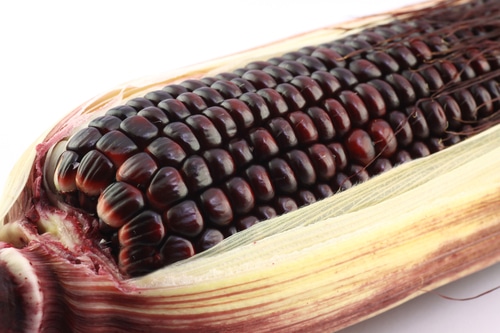
Purple Foods You May Not Have Tried
You may have seen purple cauliflower at your local supermarket or even enjoyed the taste of purple tomatoes or purple kale. These days you can also find purple asparagus, purple peppers, and purple carrots. If you look carefully, you can also find purple potatoes at some grocery stores and farmer’s markets. This deeply colored variety of potato has almost four times the antioxidant content of a regular one.
You probably don’t think of corn as being a power veggie but purple corn is. Traditionally, it’s been grown in mountainous regions of South American where it’s not only used as food but to naturally color foods without the need for synthetic chemicals. Expect to see more of it here since it has more than twice the antioxidant power of blueberries, putting yellow corn to shame. Who can resist purple corn on the cob?
Why Purple Foods Belongs in Your Grocery Cart
The power of purple comes from anthocyanins. It’s these natural flavonoids that give purple fruits and vegetable their rich color. According to research, anthocyanins subdue inflammation, the underlying force behind a variety of health problems from heart disease to cancer. Anthocyanins may be particularly important for diabetics since preliminary research shows they protect against diabetic-related kidney disease – but you don’t have to be diabetic to get the benefits. A number of studies show that these natural purple pigments enhance visual acuity and slow down the growth of cancer cells by robbing them of the blood supply they need to grow. The anthocyanins in purple corn block the growth of human cancer cells in test tubes.
Why Don’t You See More Purple Produce at the Supermarket?
When supermarkets carry purple carrots, purple carrots and other vegetables that most people don’t think of as purple, some customers mistakenly believe they’ve been artificially dyed. Far from it. They’re not seeing vegetables dyed with synthetic coloring but nature’s natural anthocyanins. In fact, food manufacturers are hoping to use anthocyanins in the food and cosmetic industry as an alternative to synthetic dyes. So breathe easy when you see a head of purple cauliflower or purple asparagus, it’s not artificially-colored. It’s colored by nature.
Enjoy the Health Benefits of Purple Foods
If you can’t find purple produce at your local supermarket, visit your local farmer’s market. When you buy, for example, purple cauliflower you won’t notice a distinct taste difference. It’s quite mild in flavor. When you cook it, expect it to lose a bit of its rich purple color, especially if you expose it to acid from acidic marinades or vinegar but it will still look pretty on your plate.
The Bottom Line?
Tap into the power of purple by adding more purple produce to the table. Start the day with an array of richly-colored berries to your oatmeal, cereal or yogurt parfait. Add Belgian endive, purple carrots and red cabbage in your salad. Skip the mashed potatoes and make purple mashed cauliflower seasoned with pesto sauce so the natural oils in the sauce will help you absorb the anthocyanins – and if you have the chance, enjoy purple corn on the cob this summer! Could purple popcorn be far behind?
References:
Science Daily. “Compound Found in Purple Corn May Aid in Developing Future Treatments for Type 2 Diabetes, Kidney Disease”
Asia Pac J Clin Nutr. 2007;16(2):200-8.
FoodNavigator-USA.com. “The Color Purple: Suntava Launches Mission to Elevate Purple Corn to Superfood Status’
Pennington Nutrition Series. “Anthocyanins”
Related Articles By Cathe:
Purple Produce: Discover the Health Benefits of Purple Fruits and Vegetables

